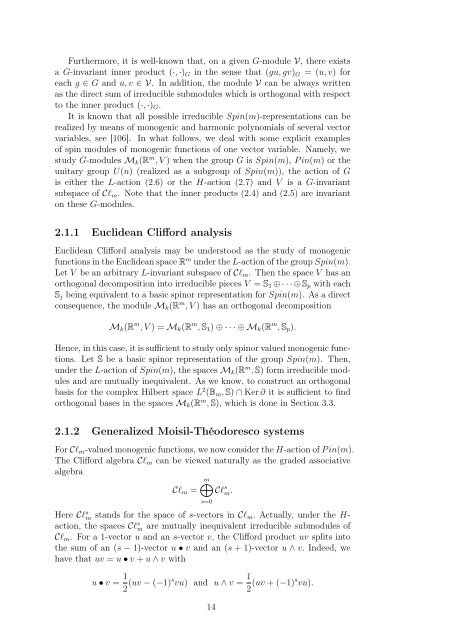Hypercomplex Analysis Selected Topics
Hypercomplex Analysis Selected Topics
Hypercomplex Analysis Selected Topics
Create successful ePaper yourself
Turn your PDF publications into a flip-book with our unique Google optimized e-Paper software.
Furthermore, it is well-known that, on a given G-module V, there exists<br />
a G-invariant inner product (·, ·)G in the sense that (gu, gv)G = (u, v) for<br />
each g ∈ G and u, v ∈ V. In addition, the module V can be always written<br />
as the direct sum of irreducible submodules which is orthogonal with respect<br />
to the inner product (·, ·)G.<br />
It is known that all possible irreducible Spin(m)-representations can be<br />
realized by means of monogenic and harmonic polynomials of several vector<br />
variables, see [106]. In what follows, we deal with some explicit examples<br />
of spin modules of monogenic functions of one vector variable. Namely, we<br />
study G-modules Mk(R m , V ) when the group G is Spin(m), P in(m) or the<br />
unitary group U(n) (realized as a subgroup of Spin(m)), the action of G<br />
is either the L-action (2.6) or the H-action (2.7) and V is a G-invariant<br />
subspace of Cℓm. Note that the inner products (2.4) and (2.5) are invariant<br />
on these G-modules.<br />
2.1.1 Euclidean Clifford analysis<br />
Euclidean Clifford analysis may be understood as the study of monogenic<br />
functions in the Euclidean space R m under the L-action of the group Spin(m).<br />
Let V be an arbitrary L-invariant subspace of Cℓm. Then the space V has an<br />
orthogonal decomposition into irreducible pieces V = S1 ⊕ · · · ⊕ Sp with each<br />
Sj being equivalent to a basic spinor representation for Spin(m). As a direct<br />
consequence, the module Mk(R m , V ) has an orthogonal decomposition<br />
Mk(R m , V ) = Mk(R m , S1) ⊕ · · · ⊕ Mk(R m , Sp).<br />
Hence, in this case, it is sufficient to study only spinor valued monogenic functions.<br />
Let S be a basic spinor representation of the group Spin(m). Then,<br />
under the L-action of Spin(m), the spaces Mk(R m , S) form irreducible modules<br />
and are mutually inequivalent. As we know, to construct an orthogonal<br />
basis for the complex Hilbert space L 2 (Bm, S) ∩ Ker ∂ it is sufficient to find<br />
orthogonal bases in the spaces Mk(R m , S), which is done in Section 3.3.<br />
2.1.2 Generalized Moisil-Théodoresco systems<br />
For Cℓm-valued monogenic functions, we now consider the H-action of P in(m).<br />
The Clifford algebra Cℓm can be viewed naturally as the graded associative<br />
algebra<br />
m<br />
Cℓm = Cℓ s m.<br />
s=0<br />
Here Cℓ s m stands for the space of s-vectors in Cℓm. Actually, under the Haction,<br />
the spaces Cℓ s m are mutually inequivalent irreducible submodules of<br />
Cℓm. For a 1-vector u and an s-vector v, the Clifford product uv splits into<br />
the sum of an (s − 1)-vector u • v and an (s + 1)-vector u ∧ v. Indeed, we<br />
have that uv = u • v + u ∧ v with<br />
u • v = 1<br />
2 (uv − (−1)s vu) and u ∧ v = 1<br />
2 (uv + (−1)s vu).<br />
14

















